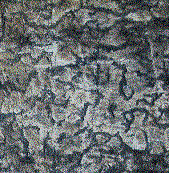

Vermiculation in caves
The picture on the left shows the rock wall of a cave with vermiculations (black worm-shaped in the picture). This phenomenon is frequently observed in underground environments and corresponds to the spontaneous formation of aggregates of materials initially present on the walls (clays, calcite, organic matter, etc). This phenomenon might become an issue in a painted cave because it can move the pigments and therefore damage the paintings. The purpose of this study is to understand the mechanisms responsible for the loss of cohesion of the material on the wall, with the aim of improving the preservation of prehistoric painted caves.
J. Martin et F. Doumenc EPL 138, 13001 (2022)
doi:10.1209/0295-5075/ac5cdc


Heat transfer in karstic massifs
Karstic massifs are complex geological structures, containing networks of underground rivers, caves and conduits. Caves represent fragile ecosystems where biogeochemical processes largely depend on cave temperature. Caves also host unique environmental records whose interpretation closely depends on temperature as well. It is therefore important to identify the spatial and temporal evolution of the temperature field according to the massif morphology and to the climatic conditions. The figure on the left is a numerical simulation illustrating at a given time the thermal disturbance induced by the presence of a shallow cave (about ten meters below the surface) in a limestone massif.
B. Qaddah et al. Int. J. Therm. Sci. 177, (2022)
https://doi.org/10.1016/j.ijthermalsci.2022.107524




Role of free convection on solute transport in a microfluidic channel
We studied the role of solutal free convection on the mixing of solutions with different concentrations in a horizontal microfluidic channel (lateral sizes in the range 5-500 µm). Using 2D and 3D numerical simulations along with asymptotic models, the solute transport is described by a succession of regimes depending on the Rayleigh number. Our work allows to predict conditions such that free convection cannot be neglected. We also provide a quantitative description of gravitational flows at the microfluidic scale.
J.B. Salmon, L. Soucasse, F. Doumenc Phys. Rev. Fluids 6,034501 (2021)
DOI: https://doi.org/10.1103/PhysRevFluids.6.034501

| 





